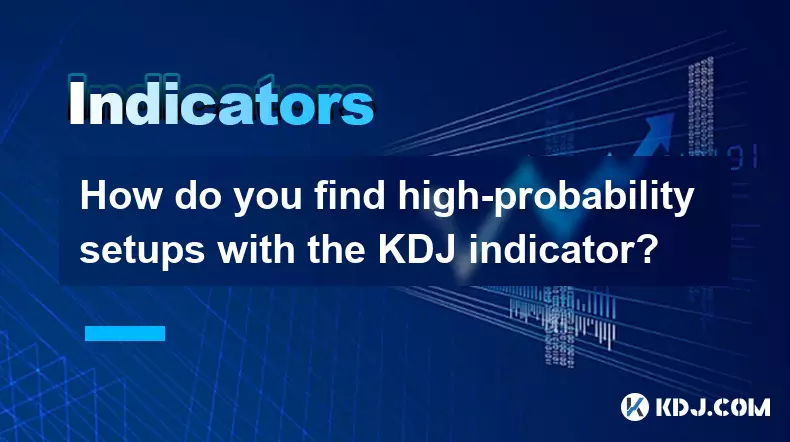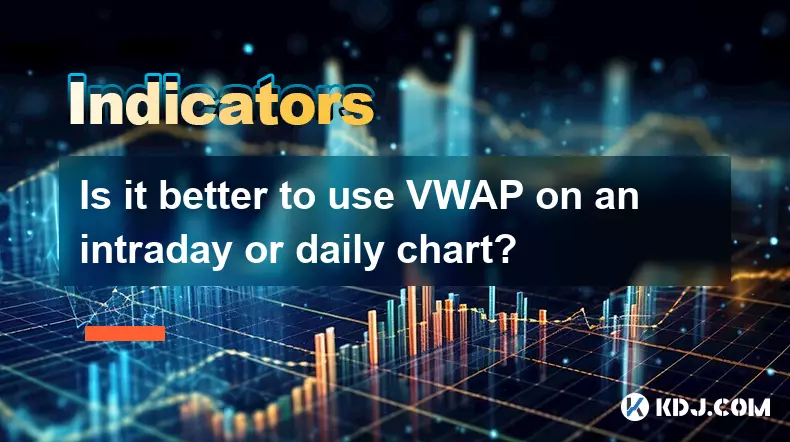-
 bitcoin
bitcoin $110918.433029 USD
-1.69% -
 ethereum
ethereum $3996.872473 USD
-2.43% -
 tether
tether $1.000594 USD
0.00% -
 bnb
bnb $1178.871834 USD
-2.38% -
 xrp
xrp $2.413973 USD
-3.47% -
 solana
solana $194.341461 USD
-4.24% -
 usd-coin
usd-coin $0.999963 USD
-0.03% -
 tron
tron $0.320092 USD
0.92% -
 dogecoin
dogecoin $0.196919 USD
-3.42% -
 cardano
cardano $0.669585 USD
-3.63% -
 hyperliquid
hyperliquid $37.485952 USD
-3.58% -
 ethena-usde
ethena-usde $1.000026 USD
-0.02% -
 chainlink
chainlink $18.018220 USD
-5.13% -
 bitcoin-cash
bitcoin-cash $523.879267 USD
-2.41% -
 stellar
stellar $0.324655 USD
-3.67%
How do you find high-probability setups with the KDJ indicator?
The KDJ indicator helps spot high-probability crypto trade setups when combined with price action, trend filters, and volume confirmation for improved accuracy.
Oct 14, 2025 at 05:54 pm

Finding High-Probability Setups Using the KDJ Indicator
The KDJ indicator, a derivative of the stochastic oscillator, is widely used in cryptocurrency trading to identify potential reversal points and momentum shifts. Traders rely on its sensitivity to price action for spotting high-probability entry and exit zones. When applied correctly within a broader analytical framework, the KDJ can significantly improve trade accuracy.
Understanding the Components of the KDJ Indicator
- The K line represents the fast stochastic value and reflects current momentum based on recent price closes.
- The D line is a moving average of the K line, offering smoothed signals that reduce market noise.
- The J line measures the distance between K and D, often signaling overextended conditions when it diverges sharply.
- Readings above 80 typically indicate overbought territory, while values below 20 suggest oversold levels.
- Crossovers between the K and D lines are commonly interpreted as buy or sell signals depending on direction and context.
Traders should monitor divergence between price and the J line, as this often precedes strong reversals in volatile crypto markets.
Combining KDJ with Price Action Analysis
- Look for bullish KDJ crossovers (K crossing above D) near key support levels or after a clear downtrend exhaustion pattern.
- Confirm bearish crossovers (K crossing below D) with resistance rejections such as wicks or engulfing candles on higher timeframes.
- Use horizontal support/resistance zones to filter false signals generated during sideways market phases.
- Align KDJ signals with chart patterns like double bottoms or ascending triangles for higher confidence entries.
- Pay attention to volume spikes coinciding with KDJ turning points, especially in low-cap altcoins where manipulation is common.
A confluence of KDJ crossover, structural price level, and increasing volume dramatically increases the reliability of a setup.
Filtering Signals with Trend Confirmation Tools
- Apply a 50-period EMA on the price chart to determine the prevailing trend; only take long setups when price is above the moving average.
- Use ADX readings above 25 to confirm a strong trend exists, reducing whipsaw trades during consolidation periods.
- Incorporate higher timeframe KDJ alignment—e.g., daily chart showing oversold condition supports long entries on the 4-hour chart.
- Avoid counter-trend trades even if KDJ reaches extreme levels unless there’s clear evidence of trend exhaustion.
- Monitor BTC dominance trends, as broad market shifts can invalidate isolated altcoin signals regardless of KDJ readings.
Managing Risk Around KDJ-Based Entries
- Place stop-loss orders just beyond recent swing highs or lows, not based solely on indicator values.
- Scale out of positions when the J line approaches extreme areas (>90 or
- Adjust position size according to volatility; tighter ranges allow larger exposure, wide swings demand smaller allocations.
- Reassess the trade if the KDJ fails to follow through after a crossover—early exit prevents losses from fakeouts.
- Never rely exclusively on KDJ without considering funding rates, exchange flows, or macro news affecting sentiment.
Proper risk management turns statistically favorable setups into consistent profitability, even if not every trade wins.
Frequently Asked Questions
What timeframes work best with the KDJ indicator in crypto trading?The 4-hour and daily charts provide optimal balance between signal quality and noise reduction. Shorter timeframes like 15-minute generate excessive false signals due to market volatility.
Can the KDJ indicator be used effectively during low-volume periods?Its effectiveness diminishes during low liquidity because price movements become erratic and less reflective of true momentum. It's advisable to wait for volume confirmation before acting on KDJ signals in such conditions.
How do you adjust KDJ settings for different cryptocurrencies?Major coins like Bitcoin and Ethereum respond well to default settings (9,3,3). For more volatile altcoins, increasing the smoothing period to (14,3,3) helps filter out misleading fluctuations.
Is the KDJ suitable for automated trading strategies?Yes, but only when combined with additional filters such as volatility bands or order book depth. Pure KDJ-based bots tend to underperform due to frequent whipsaws in 24/7 crypto markets.
Disclaimer:info@kdj.com
The information provided is not trading advice. kdj.com does not assume any responsibility for any investments made based on the information provided in this article. Cryptocurrencies are highly volatile and it is highly recommended that you invest with caution after thorough research!
If you believe that the content used on this website infringes your copyright, please contact us immediately (info@kdj.com) and we will delete it promptly.
- Hedera (HBAR) to $1: Can It Actually Happen?
- 2025-10-17 03:05:15
- Nevada Coin Mart: Where the Sparkle Meets Serious Coin Collecting
- 2025-10-17 02:45:17
- Solaxy, Super Pepe, and Presales: What's the Buzz?
- 2025-10-17 03:05:15
- $IPO Token Presale: Aiming for $100M AUM and Revolutionizing Early Investment
- 2025-10-17 02:45:17
- Binance Under Fire: Outflows, FUD Campaigns, and the Fight for User Confidence
- 2025-10-17 02:50:01
- Lombard, Bitcoin, and IP Rails: Revolutionizing the Creator Economy
- 2025-10-17 02:50:01
Related knowledge

What's the main difference between VWAP and TWAP?
Oct 12,2025 at 11:54am
Understanding VWAP and Its Role in Crypto Trading1. Volume Weighted Average Price (VWAP) is a trading benchmark that calculates the average price of a...

How do you identify exhaustion moves using VWAP and its bands?
Oct 12,2025 at 08:00am
Understanding the Role of Decentralized Exchanges in Crypto Trading1. Decentralized exchanges (DEXs) operate without a central authority, allowing use...

Is it better to use VWAP on an intraday or daily chart?
Oct 15,2025 at 02:01am
Intraday Trading and the Role of VWAP1. Intraday traders frequently rely on VWAP (Volume Weighted Average Price) as a dynamic benchmark for assessing ...

How do you use VWAP to scale in and out of positions?
Oct 14,2025 at 02:19am
Understanding VWAP as a Dynamic Benchmark1. The Volume Weighted Average Price (VWAP) is not just an indicator—it functions as a dynamic benchmark that...

What are the main advantages of using VWAP over EMA?
Oct 11,2025 at 02:18am
Main Advantages of Using VWAP Over EMA1. Volume-Weighted Average Price (VWAP) incorporates trading volume into its calculation, offering a more accura...

How do you use VWAP on different chart types like Heikin Ashi?
Oct 11,2025 at 05:01pm
Understanding VWAP in the Context of Heikin Ashi Charts1. The Volume Weighted Average Price (VWAP) is a powerful analytical tool commonly used by trad...

What's the main difference between VWAP and TWAP?
Oct 12,2025 at 11:54am
Understanding VWAP and Its Role in Crypto Trading1. Volume Weighted Average Price (VWAP) is a trading benchmark that calculates the average price of a...

How do you identify exhaustion moves using VWAP and its bands?
Oct 12,2025 at 08:00am
Understanding the Role of Decentralized Exchanges in Crypto Trading1. Decentralized exchanges (DEXs) operate without a central authority, allowing use...

Is it better to use VWAP on an intraday or daily chart?
Oct 15,2025 at 02:01am
Intraday Trading and the Role of VWAP1. Intraday traders frequently rely on VWAP (Volume Weighted Average Price) as a dynamic benchmark for assessing ...

How do you use VWAP to scale in and out of positions?
Oct 14,2025 at 02:19am
Understanding VWAP as a Dynamic Benchmark1. The Volume Weighted Average Price (VWAP) is not just an indicator—it functions as a dynamic benchmark that...

What are the main advantages of using VWAP over EMA?
Oct 11,2025 at 02:18am
Main Advantages of Using VWAP Over EMA1. Volume-Weighted Average Price (VWAP) incorporates trading volume into its calculation, offering a more accura...

How do you use VWAP on different chart types like Heikin Ashi?
Oct 11,2025 at 05:01pm
Understanding VWAP in the Context of Heikin Ashi Charts1. The Volume Weighted Average Price (VWAP) is a powerful analytical tool commonly used by trad...
See all articles










































































